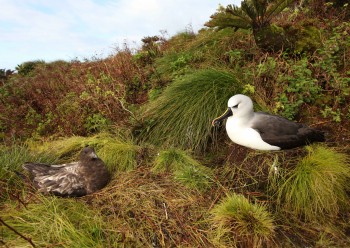Albatrosses and skuas generally make uneasy neighbours. On Gough Island breeding Atlantic Yellow-nosed Albatrosses Thalassarche chlororhynchos tend to look up suspiciously when a predatory Tristan Skua Catharacta antarctica hamiltoni flies overhead too low for comfort.
On Gough skuas do commonly breed within and on the edges of loose colonies of yellow-nosed albatrosses but distances between their nests are likely to be of the order of 5-10 metres or more. Unusual then to see an incubating skua and a yellow-nosed albatross breeding with the facing edges of their nests no more than a metre apart beside the Gony River path as we descended from surveys in the mountains of Gough last month.
Field researchers remaining on the island for the year will be able to follow the fortunes of these two breeding attempts to see if the spirit of interspecific friendship remains.
¿Amigos para siempre?

With thanks to Peter Ryan for the photograph.
Research on ACAP-listed species on the outer islands of Tristan da Cunha is funded by the UK's Overseas Territories Environment Programme and theDarwin Initiative Programme via the Royal Society for the Protection of Birds and by the FitzPatrick Institute, University of Cape Town. It is conducted with the support and approval of the Tristan Conservation Department and the logistic support of the South African Department of Environmental Affairs.
John Cooper, ACAP Information Officer, 09 October 2013

 English
English  Français
Français  Español
Español